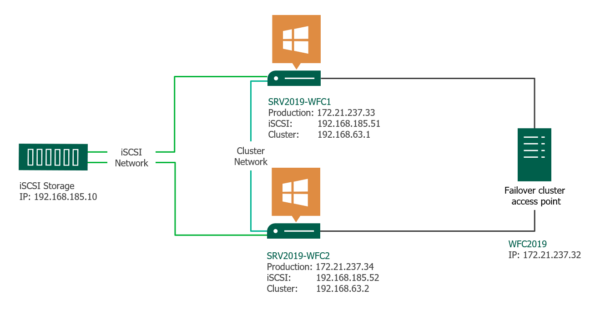Brief Information about Failover:
Failover is a critical component of network architecture that ensures continuous availability and reliability of services by automatically switching to a backup system or resource in the event of a primary system failure. It is an essential aspect of disaster recovery and business continuity planning, minimizing downtime and maintaining uninterrupted operations.
Detailed Information about Failover:
Failover mechanisms are designed to detect failures in real-time and swiftly redirect traffic or resources to alternative components, thereby preventing service disruptions. This process involves monitoring the health and performance of primary systems and swiftly initiating failover procedures when anomalies or failures are detected. Failover can occur at various levels within a network, including hardware, software, and application layers.
Detailed Analysis of Key Features of Failover:
Key features of failover mechanisms include:
- Automatic Detection: Failover systems continuously monitor the status of primary resources and swiftly detect failures or performance degradation.
- Redundancy: Failover systems rely on redundant components or resources to ensure seamless transition in the event of a failure.
- Fast Switchover: Failover mechanisms are designed to initiate rapid switchover to backup systems or resources to minimize downtime.
- Health Monitoring: Failover systems utilize health checks and monitoring tools to assess the availability and performance of primary resources.
- Load Balancing: Some failover solutions incorporate load balancing capabilities to distribute traffic efficiently across multiple resources.
Types of Failover:
Failover mechanisms can be categorized into several types based on their implementation and scope:
- Hardware Failover: Involves redundant hardware components that automatically take over operations in case of a failure.
- Software Failover: Relies on redundant software instances or virtualized environments to maintain service continuity.
- Database Failover: Ensures continuous access to data by switching to standby databases in case of primary database failure.
- Network Failover: Redirects network traffic to alternative paths or connections in the event of link failures or congestion.
| Type | Description |
|---|---|
| Hardware Failover | Relies on redundant hardware components to ensure uninterrupted operations. |
| Software Failover | Utilizes redundant software instances or virtualized environments for seamless failover. |
| Database Failover | Ensures continuous access to data by switching to standby databases in case of primary database failure. |
| Network Failover | Redirects network traffic to alternative paths or connections in the event of failures or congestion. |
Ways to Use Failover:
Failover mechanisms find applications across various industries and scenarios, including:
- Data Centers: Failover ensures high availability of critical services and applications hosted in data centers.
- Telecommunications: Telecom networks rely on failover to maintain connectivity and minimize service disruptions.
- E-commerce: Online retailers utilize failover to ensure uninterrupted access to their websites and shopping platforms.
- Healthcare: Failover systems are crucial in healthcare settings to ensure continuous access to electronic health records and patient data.
- Finance: Financial institutions deploy failover solutions to maintain uninterrupted access to trading platforms and banking services.
Problems and Solutions with Failover:
While failover mechanisms are highly effective in minimizing downtime, several challenges may arise:
- False Positives: Incorrect detection of failures may trigger unnecessary failover events, leading to service degradation. Implementing robust monitoring and threshold settings can mitigate this issue.
- Complexity: Managing and configuring failover systems can be complex, particularly in large-scale environments. Automation and orchestration tools can streamline deployment and management processes.
- Cost: Implementing redundant hardware and software components can incur additional costs. However, the benefits of minimizing downtime often outweigh the initial investment.
Main Characteristics and Comparisons:
| Characteristic | Failover | High Availability |
|---|---|---|
| Definition | Automatic switching to backup systems in case of failure | Continuous availability of services without interruptions |
| Scope | Can encompass hardware, software, and network components | Primarily focused on software and network layers |
| Redundancy | Relies on redundant components or resources for seamless transition | Utilizes redundant configurations for continuous operation |
| Speed | Swift switchover to minimize downtime | Ensures rapid recovery from failures |
| Complexity | May involve complex configurations and management | Generally simpler to implement and manage |
| Cost | Can incur additional costs for redundant hardware and resources | Initial investment typically lower compared to failover solutions |
Perspectives and Future Technologies:
As technology evolves, failover mechanisms are expected to become more sophisticated and seamlessly integrated into network infrastructures. Key areas of development include:
- Automation: Increasing automation and machine learning capabilities to enhance failover decision-making and response times.
- Software-Defined Networking (SDN): SDN technologies offer dynamic and programmable network architectures, facilitating more efficient failover mechanisms.
- Edge Computing: Failover solutions optimized for edge computing environments to ensure high availability of edge services and applications.
VPN and Failover:
Virtual Private Networks (VPNs) play a crucial role in failover strategies by providing secure and reliable connectivity between distributed resources and users. VPN failover ensures uninterrupted access to critical resources, even in the event of network failures or disruptions. By leveraging VPN technology, organizations can establish resilient network infrastructures that guarantee continuous operation and data protection.
Links to Resources:
For more information about failover mechanisms and best practices, consider exploring the following resources:


